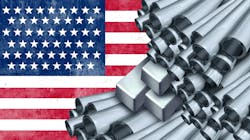The U.S. Department of Commerce has added 407 product categories to the list of “derivative” steel and aluminum products covered by Section 232 sectoral tariffs, including commercial trailers. As a result, the steel and aluminum content of these products will be subject to a duty rate of 50%, according to the August 19 announcement.
The action also covers products such as wind turbines and their parts, mobile cranes, bulldozers, and other heavy equipment, railcars, furniture, compressors and pumps, and hundreds of others.
“Today’s action expands the reach of the steel and aluminum tariffs and shuts down avenues for circumvention—supporting the continued revitalization of the American steel and aluminum industries,” Under Secretary of Commerce for Industry and Security Jeffrey Kessler said.
The American Trailer Manufacturers Coalition in May asked Commerce to include refrigerated and dry van trailers, and their subassemblies in the Section 232 list. The ad hoc coalition of U.S. trailer manufacturers includes Great Dane, Stoughton Trailers, Strick Trailers, and Wabash, according to advisory firm Wiley Rein, which submitted the requests.
“The coalition welcomes the administration’s action to address the unfair trade practices impacting the U.S. chassis industry,” said Robert E. DeFrancesco, partner in Wiley’s International Trade Practice and counsel to the coalition. “Commerce’s decision to impose Section 232 derivative tariffs on these imports is an important step toward restoring fair competition and protecting domestic manufacturing.”
The American Primary Aluminum Association likewise applauded the action.
“The additional products now subject to the 50% aluminum tariff consume significant amounts of aluminum, largely sourced from foreign entities that do not play by free market rules," said APAA President Mark Duffy. "This action sends a clear message that the United States will continue to strengthen the tariff program to combat ongoing predatory trade behaviors that harm our industry and the hardworking Americans it supports."
More to come
But wait, that’s not all.


